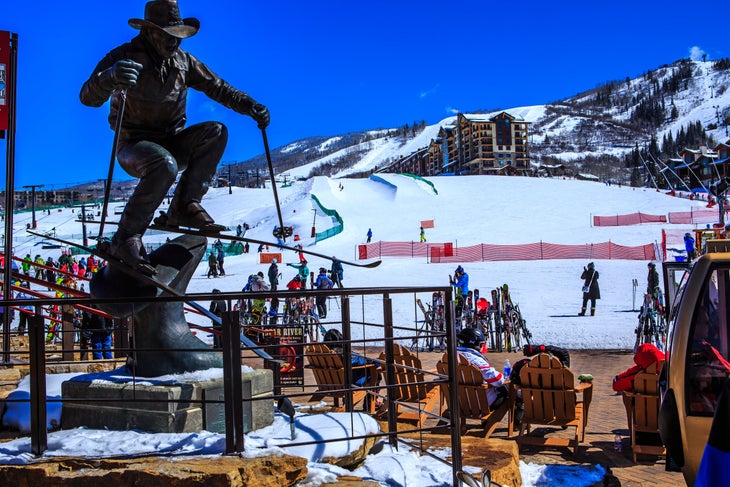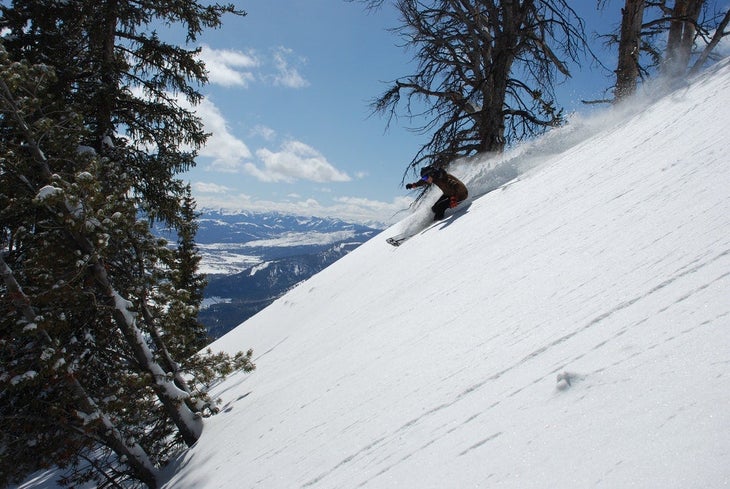For roughly four decades, the ski industry has grappled with getting more people out on the hill. Conventional wisdom says that Baby Boomers are retiring; young people aren’t picking up the slack; there’s not enough diversity; skiing is too expensive or inaccessible; and unpredictable weather due to climate change makes planning a ski vacation a costly gamble.
A year ago, total skier numbers dropped by 3 percent to 53.3 million (down from 54.8 million in the 2016-17 season), according to the National Ski Areas Association. The decrease is in line with the 40-year average.
But then, this winter happened. Skier numbers won’t be out for another few weeks, but if you believe what people are saying on chairlifts and in bars, this season should be one for the record books, both in snowfall and visitation in the Western U.S. Pulled out of drought, Mammoth Mountain, California, was buried under more than 200 inches of snow during February alone and plans to keep a lot of the mountain open until at least July 4. Skiers and riders in Utah’s Wasatch say the storms looked like “the good ole days” with powder for days on end.
However, along with the snow, there were suddenly too many people. In ski towns across the country, people complained about long lift lines, crowded buses, and not enough parking. For many locals, the primary culprit was the Ikon Pass. From Mammoth to Big Sky to Jackson Hole to Aspen to Solitude, the rookie Ikon was the talk of the town.
“I’ve lived here for 30 years and I’ve never seen lines like this nor has anyone else who’s been here for any length of time,” said Joaquin Hanson, a 73-year-old skier from Jackson Hole who is out on the hill up to five times a week.
Iconic Mountains “Ikonized”
The Ikon Pass, a new multi-resort season pass from Denver-based conglomerate Alterra Mountain Company, offers a host of ski days at 38 resorts ($899-$1,049) and is a direct competitor to the Epic Pass, Vail Resorts’ multi-resort season pass with 27 resorts ($899-$949). For some places like Steamboat, Colorado; Solitude, Utah; and Mammoth, California—among others—the Ikon acts as the de facto season pass since those resorts are owned by Alterra.
While Alterra isn’t saying how many Ikon passes it sold for winter 2018-19, the pass gave hundreds, if not thousands, of skiers an incentive to hit the road and try a spot that’d always been on their hit list. “We are thrilled with the success of the Ikon Pass, it’s doing exactly what it’s meant to do—drive skiers and riders to all destinations on the pass and invite pass-holders to explore new resorts and places they’ve always wanted to visit,” Alterra spokeswoman Kristin Rust said.
Todd Jones, co-founder of Jackson Hole-based Teton Gravity Research, agrees and sees the Ikon Pass as a welcome disruption to the one-pass/one-mountain formula.
“I think the Ikon Pass is amazing,” he said. “The ski industry has been so unattainable for so many people for so long. From hardgoods and lodging to lift tickets, everything is so expensive. Then along comes this pass that makes everything more affordable. I’m sitting here thinking, ‘Where was this thing when I was a kid?’”
But while multi-resort passes may provide a boost in skiing numbers and enthusiasm, at what point does the need for increased visitation start to erode the skiing experience? If a ski resort gets too crowded, with locals and visitors alike, what happens to the qualities that made such a destination so attractive in the first place? These are tough questions to answer as resorts attempt to balance an increase in economic vitality with their community’s values.
Locals and Tourists Vie for Powder
In Jackson Hole and Big Sky, parking lots overflowed and tram lines were often more than an hour long. Though skiers have come to expect crowds on holiday weekends, this winter they saw those crowds midweek. As the gripes mounted, including verbal altercations in lift lines and the proliferation of stickers suggesting that Ikon skiers should “go back to Colorado,” executives from three Ikon partner resorts—Jackson Hole, Big Sky, and Aspen—pleaded for civility in their local newspapers. Big Sky GM Taylor Middleton wrote in Explore Big Sky that he hopes locals treat visitors with respect, as he was when he moved to the area 40 years ago. “I’m committed to working hard to help Big Sky grow better, and I know countless others that are too,” Middleton wrote. “I’m also committed to keeping this a fun place, with loads of fun people, who do fun stuff, and I know a boatload of you feel the same way. We’re a friendly and welcoming bunch. Please keep sharing that, continue paying it forward.”
Bill Gamber, co-founder of Steamboat-based Big Agnes and its sister, Honey Stinger, says he definitely noticed the crowd influx this winter at his ski area. He speculated that the Ikon gave Front Rangers the chance to bypass familiar trips to Summit County along the dreaded Interstate 70 and ski Steamboat instead.
“Whereas in the past they might come to Steamboat once a winter, they are now coming more often,” Gamber said. “We definitely seemed to be affected by the Ikon, but not in a bad way. More people are loving skiing and that’s great for the businesses in town, but it’s a double-edged sword. The balance is in sustaining business but then still being able to do the things you love to do. This year, you just had to hunt a little harder to find the powder.”
Andy Olpin, who has owned and operated Wilson Backcountry Sports in Jackson Hole for 26 years, chuckled when asked about the Ikon Pass, joking that it was everyone’s favorite target if they were having a bad day. “We probably saw some residual business,” he said. “But as a backcountry shop, they’re not our typical customer.”

While locals claimed it was the “Ikoneers” gumming up the works, others pushed back, arguing that it was more complex than placing blame on any one group. In February, Jackson Hole Mountain Resort President Mary Kate Buckley wrote in the Jackson Hole News and Guide that locals accounted for nearly 40 percent of skier days, whereas Ikon passholders attributed just 16 percent. Aspen-Snowmass president Mark Kaplan similarly noted that local season pass use was up 40 percent, while the Ikon accounted for 8 to 15 percent.
Just this week, both Jackson Hole and Aspen announced that they were bundling the benefits of the Ikon Base Pass—providing five days of skiing at 25 resorts, and unlimited skiing at 12—with the purchase of a full season pass. Though this may alleviate the gripe that locals were being treated unfairly, it likely does not address concerns of crowding.
Big Sky Resort argues that the increase in tourism is good for the community and helps support local initiatives like workforce housing.
“Ikon visitation represents an important, albeit smaller portion of our growth in skier visitation this season,” said Stacie Mesuda, Big Sky Resort’s public relations manager. “Additional visitation allows for [us] to improve the guest and employee experience, such as adding 75 additional beds of seasonal workforce housing this summer, adding more than 250 free parking spots, and completely remodeling the Mountain Mall food hall with 300 additional seats.”

Traffic Jam in the Mountains
Whether it was Ikon passholders, locals, or tourists in general, the increase in visitation laid bare the poor travel habits of skiers. In the age of social media, where millions of people are alerted to storms and powder days in a moment’s notice, suddenly everyone drives their own personal car to the ski hill at the same time.
In the Wasatch, the traffic was particularly bad this winter, even in Big Cottonwood, which has historically seen fewer traffic issues than its neighbor Little Cottonwood. All four resorts in the Cottonwood Canyons accepted the Ikon Pass this winter. w: “Ikon, Epic passes may be working too well. They make already-bad traffic in Utah’s Cottonwood Canyons even worse.” In the article, Alta GM Mike Maughn said that a third of all cars in the ski area’s upper lot were rental cars.
But longtime Solitude skier Nick Como said blaming the Ikon Pass ignores the bigger issue.
“The congestion caused by single-occupant vehicles really underscores the need to rethink canyon transportation on a holistic level,” he said. “Parking lots fill up earlier [across the Wasatch] which means skiers have to get on the road even earlier to snag a spot on weekends and powder days. More parking isn’t the solution, and the Ikon Pass is often pointed to as the cause. It’s not, in my opinion. It’s our behavior and reliance on cars that needs to change.”
Along Colorado’s Front Range, Eldora Mountain just 20 miles from Boulder went through similar growing pains this winter, as the majority of its business came from the Ikon, according to marketing manager Sam Bass.
“As devoted skiers and as an industry as whole, we shoot ourselves in the foot when we don’t welcome new skiers or more skiers,” Bass said. “People complain about high prices and they want the industry to flourish, but then they get mad when these multi-mountain passes bring new and more people to the sport.”
To alleviate traffic congestion to Eldora, the mountain created several initiatives aimed at getting people to carpool or use the bus. The ski area created online forums for people to hook up for carpool, and gave away $10,000 in free bus passes. (This came after Eldora received major pushback for announcing it would impose $20 parking fees for vehicles with fewer than three occupants.)
“If we want the sport of skiing and snowboarding to continue to thrive, we need to appeal to as many people as we can and figure out how to get them on snow and give them a good experience, and figure out how we do it in sustainable way so that the industry can still exist in 50 years and still have enough snow,” Bass said.
As ski season winds down and resorts discuss how to better manage crowds next season, the winners are skiers who take advantage of the Ikon and, of course, Alterra.
If you’re local, you can always hope for less snow next year.


